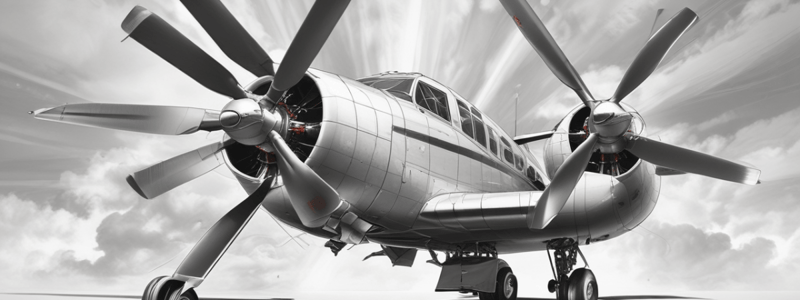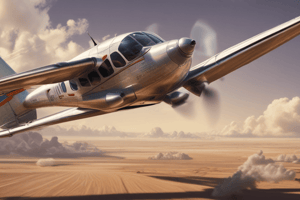Podcast
Questions and Answers
What is the primary advantage of using composite materials in propeller construction?
What is the primary advantage of using composite materials in propeller construction?
- High strength-to-drag ratio
- Low strength-to-weight ratio
- High strength-to-weight ratio (correct)
- Low strength-to-drag ratio
What characteristic of the airfoil shape is critical for propeller efficiency?
What characteristic of the airfoil shape is critical for propeller efficiency?
- Drag-to-lift ratio
- Weight-to-thrust ratio
- Lift-to-drag ratio (correct)
- Thrust-to-weight ratio
What is the primary purpose of blade twist in propeller design?
What is the primary purpose of blade twist in propeller design?
- To increase the thrust-to-weight ratio
- To reduce the weight of the propeller
- To increase the lift-to-drag ratio
- To reduce the effect of P-factor (correct)
What is a critical consideration for hub design in propeller construction?
What is a critical consideration for hub design in propeller construction?
What is the primary challenge in optimizing propeller design?
What is the primary challenge in optimizing propeller design?
What is the primary benefit of incorporating blade twist in propeller design?
What is the primary benefit of incorporating blade twist in propeller design?
What is the primary function of the hub in a variable-pitch propeller?
What is the primary function of the hub in a variable-pitch propeller?
What is the primary consideration for airfoil shape design in propeller blades?
What is the primary consideration for airfoil shape design in propeller blades?
What is the primary benefit of using a high-strength material in propeller construction?
What is the primary benefit of using a high-strength material in propeller construction?
What is the primary consequence of failing to balance the numerous factors involved in propeller design?
What is the primary consequence of failing to balance the numerous factors involved in propeller design?
The propeller's hub design is not crucial to overall performance.
The propeller's hub design is not crucial to overall performance.
The airfoil shape of the propeller blade remains constant along the length of the blade.
The airfoil shape of the propeller blade remains constant along the length of the blade.
Aerodynamic efficiency is the primary factor in propeller design.
Aerodynamic efficiency is the primary factor in propeller design.
P-factor is a desirable effect in propeller design.
P-factor is a desirable effect in propeller design.
The pitch of the propeller blade is constant from hub to tip.
The pitch of the propeller blade is constant from hub to tip.
The strength-to-weight ratio of a material is irrelevant in propeller design.
The strength-to-weight ratio of a material is irrelevant in propeller design.
The lift-to-drag ratio of the airfoil is not important for propeller efficiency.
The lift-to-drag ratio of the airfoil is not important for propeller efficiency.
The diameter of the propeller is the only factor that affects its efficiency.
The diameter of the propeller is the only factor that affects its efficiency.
The main purpose of the hub is to provide a decorative cover for the propeller.
The main purpose of the hub is to provide a decorative cover for the propeller.
A well-designed propeller can only operate efficiently in a single flight condition.
A well-designed propeller can only operate efficiently in a single flight condition.
How do designers address the issue of asymmetric loading on propeller blades during different angles of attack?
How do designers address the issue of asymmetric loading on propeller blades during different angles of attack?
What is the primary advantage of using materials with high strength-to-weight ratios in propeller construction?
What is the primary advantage of using materials with high strength-to-weight ratios in propeller construction?
How do the airfoil shapes of propeller blades change along the length of the blade, and why is this necessary?
How do the airfoil shapes of propeller blades change along the length of the blade, and why is this necessary?
What is the primary purpose of the hub in a propeller, and what are the key considerations in its design?
What is the primary purpose of the hub in a propeller, and what are the key considerations in its design?
What is the ultimate goal of optimizing propeller design, and what factors must be balanced to achieve it?
What is the ultimate goal of optimizing propeller design, and what factors must be balanced to achieve it?
What is the relationship between P-factor and blade twist in propeller design?
What is the relationship between P-factor and blade twist in propeller design?
How do designers approach the challenge of optimizing propeller efficiency, given the complex interplay of multiple design factors?
How do designers approach the challenge of optimizing propeller efficiency, given the complex interplay of multiple design factors?
What are the implications of failing to balance the numerous factors involved in propeller design?
What are the implications of failing to balance the numerous factors involved in propeller design?
How do the design elements of a propeller, such as airfoil shape and blade twist, impact its overall efficiency?
How do the design elements of a propeller, such as airfoil shape and blade twist, impact its overall efficiency?
What is the key to achieving optimal propeller performance across various flight conditions?
What is the key to achieving optimal propeller performance across various flight conditions?
Flashcards are hidden until you start studying
Study Notes
Principles of Propeller Operation
- Propeller plays a fundamental role in aircraft propulsion, converting engine power into thrust
- Basic components of a propeller: hub (attaches to the engine) and blades (artfully shaped to engage with the air)
- Each blade's curved surface is designed to exploit aerodynamic properties to generate lift and thrust
Propeller Blade Angle and Pitch
- Blade angle: the angle at which the blade is set relative to the plane of propeller rotation
- Pitch: the distance a propeller would move in one revolution if it were moving through a solid medium
- Fixed-pitch propellers maintain the same blade angle, whereas variable-pitch propellers can adjust it mid-flight for optimal performance
Propeller Slip
- Propeller slip: the propeller does not move as much air as theoretically predicted, affecting efficiency and performance
- Understanding slip is key to optimizing propeller performance
Propeller Speed and External Factors
- Propeller speed: measured in revolutions per minute (RPM)
- Relationship between RPM, blade design, altitude, and air density affects propeller performance
- External factors like air density and temperature can alter the generated thrust
Fixed-Pitch vs Variable-Pitch Propellers
- Fixed-pitch propellers: simpler and cheaper, but offer less operational flexibility
- Variable-pitch propellers: more complex and costly, but allow for adjustment in blade angle to match flying conditions, granting pilots finer control over aircraft performance
Factors Influencing Propeller Efficiency
- Blade angle and pitch
- Altitude effects on air density
- Shape and design of the propellers
- Blade velocity and angle of attack
- Aircraft weight and balance
- Shift in propeller loading during various flight phases
- Variable pitch propellers
Propeller Design
- Composite materials: high strength-to-weight ratio and resistance to corrosion
- Aerodynamic efficiency: airfoil shape, lift-to-drag ratio, and minimizing energy lost to drag
- Blade twist: incorporates pitch variation to counteract effects like P-factor
- Hub design: robust, lightweight, and reliable mechanisms for pitch adjustment
Optimizing Propeller Design
- Balancing numerous factors: diameter, blade count, pitch, material, airfoil shape, blade twist, and hub construction
- Each design decision has implications for propeller efficiency and overall aircraft performance
Principles of Propeller Operation
- Propeller converts engine power into thrust through aerodynamic forces
- Fundamental role in aircraft propulsion
- Consists of hub and blades, artfully shaped to engage with air and generate lift
- Blade angle and pitch are significant factors in propeller efficiency
- Blade angle: angle at which the blade is set relative to the plane of propeller rotation
- Pitch: distance a propeller would move in one revolution if it were moving through a solid medium
Propeller Performance
- Propeller slip: propeller does not move as much air as theoretically predicted, affecting efficiency
- Propeller speed: measured in revolutions per minute (RPM), affects performance
- Relationship between RPM, blade design, altitude, and air density must be managed for optimal performance
- External factors: air density, temperature, and altitude affect propeller performance
Propeller Types
- Fixed-pitch propeller: simpler and cheaper, but offers less operational flexibility
- Variable-pitch propeller: more complex and costly, allows for adjustment in blade angle to match flying conditions
Factors Influencing Propeller Efficiency
- Blade angle and pitch
- Altitude: air density decreases with altitude, affecting propeller efficiency
- Propeller shape and design: scimitar-shaped to paddle designs, affects efficiency
- Blade velocity and angle of attack
- Aerodynamic ceiling: propeller's efficacy faces the thin air challenge at high altitudes
Propeller Design Considerations
- Propeller diameter: larger diameters produce more thrust, but have practical limits
- Number of blades: affects efficiency, performance, and cost
- Blade pitch: adjustable in more sophisticated propeller systems
- Material: affects performance, durability, and efficiency
- Airfoil shape: maximizes thrust while minimizing energy lost to drag
- Blade twist: counteracts effects of P-factor, allowing for more uniform thrust distribution
- Hub design: robust and lightweight, with complex mechanisms for pitch adjustment in variable-pitch propellers
Principles of Propeller Operation
- Propeller operation is crucial for aircraft propulsion, converting engine power into thrust.
- The propeller's fundamental role is based on aerodynamic principles, including lift and drag.
Propeller Components
- The propeller consists of a hub and blades.
- The hub attaches the propeller to the engine.
- Blades are artfully shaped to engage with the air, exploiting aerodynamic properties to generate lift.
Aerodynamic Principles
- As the propeller rotates, blades experience a change in pressure, generating lift and thrust.
- Blade angle and pitch are significant factors in propeller efficiency.
- The blade angle is the angle at which the blade is set relative to the plane of propeller rotation.
- Pitch is the distance a propeller would move in one revolution if it were moving through a solid medium.
Factors Influencing Propeller Efficiency
- Blade angle and pitch affect the propeller's 'bite' or efficiency.
- Air density changes with altitude and temperature, altering the propeller's efficiency (aerodynamic ceiling).
- Propeller shape and design can significantly influence efficiency, optimizing thrust while reducing noise and vibration.
- Blade velocity and angle of attack affect the resultant forces, generating thrust.
- Aircraft weight and balance impact propeller efficiency and performance.
Adaptability and Variable Pitch Propellers
- Different flight phases require unique propeller settings for optimal performance.
- Variable pitch propellers allow for in-flight adjustments to blade angle, adapting to changing flight conditions.
Case Studies and Recap
- Understanding propeller efficiency is critical for successful flights, particularly in challenging conditions like takeoff on a hot day at a high-altitude airport.
- Factors influencing propeller efficiency include blade angle and pitch, altitude effects, shape and design, blade velocity and angle of attack, aircraft weight and balance, and variable pitch propellers.
Propeller Design Considerations
- Propeller diameter affects thrust, with larger diameters generally producing more thrust.
- The number of blades affects efficiency, with increased blades distributing load more evenly but also increasing drag and weight.
- Propeller blade pitch and material selection are critical design considerations.
- Aerodynamic efficiency is refined by the blade's airfoil shape, which must be designed to maximize thrust while minimizing drag.
- Blade twist can counteract effects like P-factor, ensuring uniform thrust distribution.
- Hub design is integral to overall performance, requiring robustness and lightness.
Studying That Suits You
Use AI to generate personalized quizzes and flashcards to suit your learning preferences.




